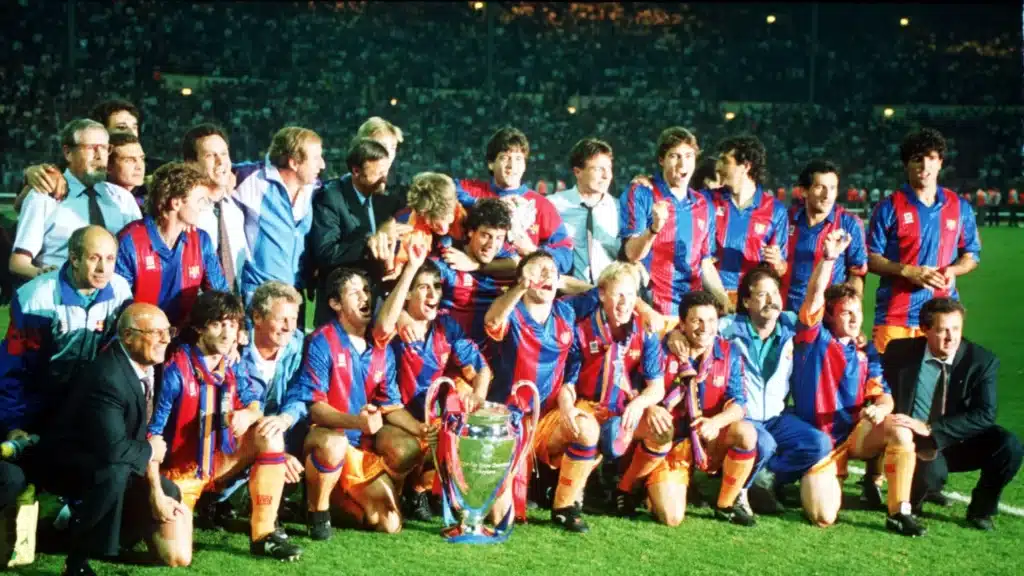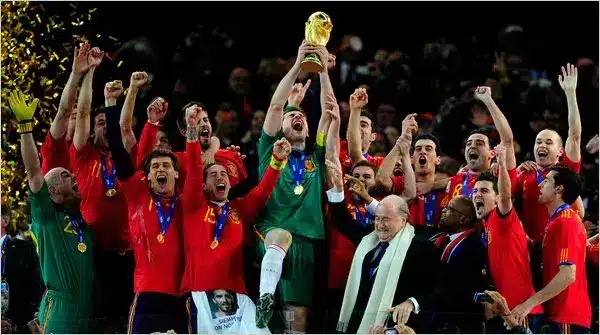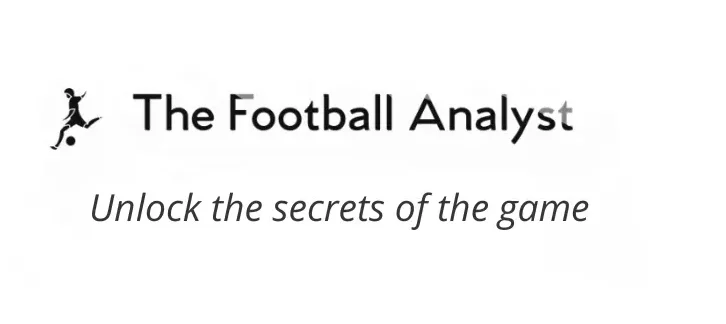Tiki-Taka is one of the most influential and recognizable football philosophies in modern history. Characterized by short, quick passing, continuous movement, and positional play, this tactical system aims to control possession, dominate the opposition, and create goal-scoring opportunities through intricate team play. Made famous by FC Barcelona and the Spanish national team, Tiki-Taka has been widely studied and imitated but also scrutinized for its limitations. This article explores the origins, principles, key proponents, and evolution of Tiki-Taka, as well as its strengths and weaknesses in the modern game.
Origins and Evolution
The roots of Tiki-Taka can be traced back to the Dutch concept of “Total Football,” pioneered by Rinus Michels and Johan Cruyff. Total Football emphasized fluid positional play, technical proficiency, and high pressing, elements that became fundamental to Tiki-Taka.
When Johan Cruyff took charge of FC Barcelona in 1988, he introduced a possession-based approach that laid the foundation for what would later become known as Tiki-Taka. He built his Barcelona “Dream Team” of the early 1990s around short passing sequences, intelligent movement, and an emphasis on maintaining control of the ball.

Cruyff’s philosophy became deeply ingrained in Barcelona’s La Masia youth academy, influencing future generations of players and coaches.
The tactical evolution continued under managers like Frank Rijkaard and was perfected by Pep Guardiola during his reign at Barcelona (2008-2012). Guardiola’s Barcelona dominated world football with a style that relied on midfield superiority, positional interchanges, and relentless pressing. Simultaneously, Spain’s national team adopted Tiki-Taka, achieving unprecedented success by winning Euro 2008, the 2010 World Cup, and Euro 2012.

While pure Tiki-Taka has faded from prominence, elements of the philosophy remain influential. Many top teams use positional play and high pressing while incorporating more direct attacking transitions. Modern managers, like Mikel Arteta and Xabi Alonso, have refined the approach by adding verticality and counterattacking threats, ensuring a balance between control and attacking efficiency.
Core Principles of Tiki-Taka
Tiki-Taka is based on several key tactical principles that define its effectiveness:
1. Possession Dominance
Tiki-Taka teams prioritize maintaining possession, often recording high percentages of ball control. The philosophy is built on the belief that as long as the team has the ball, the opposition cannot score. The approach is not just about holding onto possession for the sake of it, but about wearing down the opponent by forcing them to chase the ball. The more a team dominates possession, the more they dictate the rhythm of the game, increasing their control over proceedings and reducing their defensive vulnerabilities.
2. Short, Quick Passing
The hallmark of Tiki-Taka is rapid, short passes, usually one or two touches, to circulate the ball efficiently. This approach minimizes turnovers and keeps the opposition chasing the game. Players are constantly looking to receive the ball in tight spaces, using their close control and composure to escape pressure. The quick passing tempo forces defensive lines to shift constantly, eventually creating gaps that can be exploited in attacking areas.
3. Positional Play (Juego de Posición)
Players are trained to maintain optimal spacing on the pitch, ensuring multiple passing options at all times. This principle creates passing triangles and overloads in key areas, allowing seamless ball progression. Each player must be positioned in a way that maximizes the number of available passing lanes, ensuring that the team always has superior numbers around the ball. This concept of positional play also requires high football intelligence, as players need to understand when to move, when to stay, and when to change positions to create better angles for passing and receiving.
4. Fluid Movement and Interchanges
Off-the-ball movement is crucial in Tiki-Taka. Players constantly rotate positions, creating passing angles and space to dismantle defensive structures. This movement ensures the ball remains in circulation and the opposition cannot settle. Instead of static positioning, Tiki-Taka relies on a dynamic structure where midfielders, forwards, and even defenders interchange roles based on the needs of the situation. This fluidity confuses opposition markers and opens up spaces in key attacking areas.
5. Patience and Control
Unlike direct attacking football, Tiki-Taka is patient. The team waits for the right moment to penetrate defensive lines, often prioritizing ball retention over rushed goal attempts. By circulating the ball and waiting for the perfect moment to play a decisive pass, teams using Tiki-Taka can stretch defensive lines until weaknesses appear. The focus is not on taking speculative shots or launching hopeful crosses, but rather on methodically breaking down defenses through precision passing and intelligent movement.
6. Numerical Superiority in Key Areas
A key aspect of Tiki-Taka is creating overloads in various areas of the pitch. Whether in midfield, wide areas, or around the opposition’s penalty box, the goal is to outnumber the opponent in certain zones. This allows for quick combinations, dribbles, and passing patterns that can break defensive structures. The team ensures they always have an extra man in vital areas, making it difficult for the opposition to regain possession.
7. Press Resistance and Technical Excellence
Players in a Tiki-Taka system must be comfortable under pressure, capable of receiving the ball in tight spaces and retaining possession despite defensive challenges. This demands exceptional technical ability, close control, and quick decision-making. Every player, including defenders and goalkeepers, must be skilled in ball control and passing accuracy, ensuring seamless build-up from the back.
Strengths of Tiki-Taka
Control and Dominance
Tiki-Taka allows teams to dictate the tempo, making it difficult for opponents to build attacks. By monopolizing possession, teams can limit the opposition’s offensive opportunities, reducing the risk of conceding goals. This control also forces opponents to expend significant energy chasing the ball, leading to fatigue and lapses in concentration.
Defensive Solidity
Tiki-Taka’s philosophy is built on the belief that as long as the team has the ball, the opposition cannot score. By maintaining prolonged possession, teams using this system minimize defensive exposure and limit the opponent’s attacking chances. Possession itself becomes a defensive strategy, forcing opponents to expend energy chasing the ball while reducing their opportunities to build dangerous attacks.
Efficient Space Exploitation
The constant movement and positional play create opportunities to exploit spaces, breaking down defensive lines. The emphasis on creating numerical superiority in key areas forces opponents into uncomfortable defensive situations, leading to higher-quality goal-scoring opportunities. Well-coached Tiki-Taka teams can manipulate space so effectively that even compact low-block defenses struggle to contain their passing rhythm.
Encouragement of Technical Excellence
Tiki-Taka places immense value on technical proficiency, encouraging players to develop close ball control, quick decision-making, and spatial awareness. Players groomed in this system become highly versatile and adept at maintaining possession under pressure, a trait that benefits them regardless of tactical adaptations.
Weaknesses and Criticism
Sterile Possession
Tiki-Taka can sometimes result in excessive passing without penetration, making it easier for defensive teams to sit back and absorb pressure. If a team lacks a cutting edge in the final third, it can struggle to break down deep-lying defenses, leading to frustrating, low-scoring matches. Critics argue that some versions of Tiki-Taka prioritize keeping possession for the sake of it rather than using it as an offensive weapon.
Vulnerability to High-Intensity Pressing
Teams that press aggressively and disrupt passing lanes can unsettle Tiki-Taka teams, forcing mistakes in dangerous areas. Opponents who can execute coordinated high pressing, such as Jürgen Klopp’s Gegenpressing approach, have successfully disrupted Tiki-Taka teams by suffocating their build-up play and forcing turnovers in advanced positions.
Adaptability Challenges
Tiki-Taka requires a highly specific set of players with exceptional technical skills and game intelligence. Not every squad can seamlessly adopt this system, and managers who rigidly stick to this strategy without considering their squad’s strengths may struggle to achieve success. As football has evolved, managers have needed to incorporate elements of direct play to maintain a balance between control and penetration.
Conclusion
Tiki-Taka remains one of the most iconic tactical innovations in football history. Its emphasis on possession, movement, and pressing revolutionized the game, leading to some of the most dominant teams ever seen. While adaptations have been necessary to counteract its weaknesses, the principles of Tiki-Taka continue to shape modern football, influencing teams and coaches worldwide. Moreover, its legacy can be seen in the way many teams approach ball control, pressing, and structured positional play. As football evolves, new adaptations will emerge, but the core ideas of Tiki-Taka will likely remain a fundamental part of tactical discussions and coaching philosophies for years to come.
